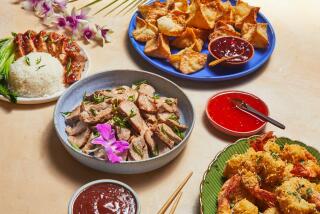The Kiwi’s Long and Vining Road
- Share via
The kiwi has come a long way since it was first introduced in the United States in the early ‘30s. The Chinese Gooseberry as it was then known, was later renamed “kiwi,” mainly for promotional purposes, after the flightless national bird of New Zealand.
When it was “rediscovered” by trendy American chefs in the early ‘80s, the kiwi turned into an instant superstar in gourmet circles. As consumer demand increased, the kiwi left culinary stardom for the more mundane world of supermarket shelves.
Last year, 60,000 trays of California kiwi were grown in San Diego County, according to the California Kiwifruit Commission.
Roger Meyer, of Valley Vista Kiwi in Valley Center, envisioned the kiwi’s commercial possibilities long before the fruit hit the popularity chart. Meyer, who owns a rare fruit nursery in Fountain Valley, took a gamble, and planted his first kiwi vines in 1975.
Much to his dismay, nothing took. “We realized we had planted the wrong variety,” he said, “so we went looking for others.” Luckily, he had several dozen to choose from. After much experimentation, Meyer, like most growers in California, settled on the hardy kiwi, which refers to all kiwis that withstand deep cold during the dormant season.
A good winter chill, Meyer found, was essential for kiwi vines to bloom, making the fruit’s commercial appeal of little interest to growers in warm climate zones. In addition, kiwis are dioecious plants, requiring both a male and a female plant for pollination, and only the female plant bears fruit. This calls for a good portion of any orchard to be planted in non-fruiting male vines. Abundant watering is another key to growing kiwis successfully. The recent drought, in fact, has caused several growers to abandon kiwi production in the North County.
Meyer’s land, however, was ideally suited for the kiwi, and today his experimental orchard thrives on a rocky hillside in Valley Center. Over a decade and a half after his first plantings, dozens of thick, twisted vines wind around the wooden trellises like sleeping pythons. Most vines are sold as grafting stock to commercial growers here and abroad. Meyer has shipped some as far as India, Egypt and Eastern Europe, all for experimental purposes.
He derives his commercial fruit crop mainly from the Hayward and the Kramer, two Hardy kiwis common throughout California. The Hayward, originally developed in New Zealand, is “a beautiful fruit” he said.
Another good bearer is the huskier Kramer, which sometimes develops into plump, fan-shaped fruit. These two “fuzzless” varieties are sweeter than most others, he explains, and can be eaten with the skin on.
Meyer has some experimental varieties on his property that he doesn’t yet quite know what to do with. One of those is the Actinidia Purpurea, a date-sized cousin of the Hayward that turns red when it ripens. Meyer twists a few off the vine, and offers samples all around: The flavor of a tangy cherry lingers on the palate.
The Allison kiwi growing nearby is an “excellent” back-yard kiwi for Southern California, Meyer said. The Monty is intolerant to drought, and definitely not suited to the North County area, unlike the Tewi, a fruit originally grown in the arid landscape of the Canary Islands.
This year, like most growers, Meyer had to curtail his watering, and his kiwi crop suffered as a result. Tumbling prices caused many kiwi growers to go under, he said. Meyer said that, given the current situation, he is thankful to be selling rootstock rather than fruit.
The future is not all bleak, however. The kiwi expert can’t contain his excitement at the thought of a new red and yellow-fleshed kiwi, which he hopes will generate as much consumer interest as the original.
Dan Lammers has planted his property in Ramona entirely with Haywards, the leading commercial variety that accounts for 99% of U.S. production. Unlike major commercial producers who pick the fruit early in order to ship it, Lammers leaves his on the vine until the sugar content is higher than is commercially required. “Our fruit tends to color a deeper green for optimum flavor,” he said.
“One of the problems is that the fruit needs 450 hours of chill under 45 degrees, which makes it chancy to grow in San Diego County,” he said.
Although kiwi vines are usually trellised, some varieties thrive in containers, according to Meyer.
Kiwis refrigerate well. The fruit is generally picked in October and placed in cold storage, to supply markets through the following spring. When shopping, choose firm kiwis and let them ripen at room temperature until they turn soft to the touch.
Slice in salads, or simply cut in half, and scoop out the flesh with a spoon. The fruit is an excellent source of Vitamin C and potassium.
Roger and Shirley Meyer, Valley Vista Kiwi. Weekends 749-1955. Weekdays: (714) 839-0796. Sells rootstock, and fruit (wholesale only.)
Dan and Nadine Lammers, Rancho San Miguel, 23728 Highway 78, Ramona, CA 92065. (619) 789-6537. Phone orders accepted. Price depends on size. $1 for 3 large kiwis, or $1 for 10 small ones.
Dietary and nutritional information available by sending a self-addressed, stamped envelope to the California Kiwifruit Commission, 1540 River Park Drive, Suite 110, Sacramento, CA 95815.
More to Read
Eat your way across L.A.
Get our weekly Tasting Notes newsletter for reviews, news and more.
You may occasionally receive promotional content from the Los Angeles Times.









